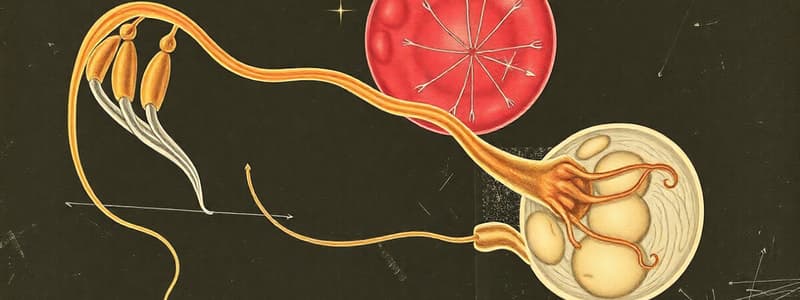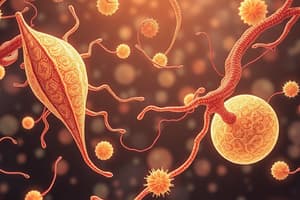Podcast
Questions and Answers
What hormone surge triggers ovulation during the late follicular phase of the ovarian cycle?
What hormone surge triggers ovulation during the late follicular phase of the ovarian cycle?
- Luteinizing hormone
- Estradiol (correct)
- Follicle-stimulating hormone
- Progesterone
Which structure connects the left and right atria in a fetus, allowing blood to bypass the lungs?
Which structure connects the left and right atria in a fetus, allowing blood to bypass the lungs?
- Pulmonary vein
- Foramen ovale (correct)
- Coronary sinus
- Ductus arteriosus
What is the primary function of the ectoderm during embryonic development?
What is the primary function of the ectoderm during embryonic development?
- Forming the liver and pancreas
- Forming the nervous system and sense organs (correct)
- Forming the heart and blood vessels
- Producing blood cells
What major hormonal change is associated with menopause in females?
What major hormonal change is associated with menopause in females?
At what stage of development is the placenta established?
At what stage of development is the placenta established?
What is the correct order of sperm travel after leaving the ductus deferens?
What is the correct order of sperm travel after leaving the ductus deferens?
Which hormone is primarily responsible for stimulating milk production during breastfeeding?
Which hormone is primarily responsible for stimulating milk production during breastfeeding?
What structure acts to regulate the temperature of the testes?
What structure acts to regulate the temperature of the testes?
What is the major outcome of meiosis?
What is the major outcome of meiosis?
Which of the following structures in the female reproductive anatomy is homologous to the male scrotum?
Which of the following structures in the female reproductive anatomy is homologous to the male scrotum?
What is the only form of prenatal nutrition available before the implantation of the blastocyst?
What is the only form of prenatal nutrition available before the implantation of the blastocyst?
Which statement accurately describes Type B daughter cells in spermatogenesis?
Which statement accurately describes Type B daughter cells in spermatogenesis?
What is the role of testosterone during male sexual development?
What is the role of testosterone during male sexual development?
What ion is released upon sperm penetration into the egg that causes the fast block (depolarization of the egg membrane)?
What ion is released upon sperm penetration into the egg that causes the fast block (depolarization of the egg membrane)?
Which layer of the blastocyst develops into the embryo during early pregnancy?
Which layer of the blastocyst develops into the embryo during early pregnancy?
Which hormone secreted by the trophoblast during implantation stimulates the corpus luteum?
Which hormone secreted by the trophoblast during implantation stimulates the corpus luteum?
What is the main source of prenatal nutrition immediately after implantation?
What is the main source of prenatal nutrition immediately after implantation?
What is the innermost layer of the uterus where embryonic attachment occurs?
What is the innermost layer of the uterus where embryonic attachment occurs?
At what week of prenatal development is lanugo covering the fetus?
At what week of prenatal development is lanugo covering the fetus?
Which hormonal change initiates the production of LH and FSH in females during puberty?
Which hormonal change initiates the production of LH and FSH in females during puberty?
What is the earliest noticeable sign of puberty in females?
What is the earliest noticeable sign of puberty in females?
Flashcards
Fast block to polyspermy
Fast block to polyspermy
A mechanism that prevents multiple sperm from fertilizing a single egg, achieved by depolarizing the egg membrane.
Inner cell mass (embryoblast)
Inner cell mass (embryoblast)
The part of the blastocyst that will become the embryo, forming the primary germ layers.
HCG (human chorionic gonadotropin)
HCG (human chorionic gonadotropin)
A hormone secreted by the trophoblast during implantation, stimulating the corpus luteum to produce estrogen and progesterone.
Endoderm
Endoderm
Signup and view all the flashcards
Embryo to Fetus transition
Embryo to Fetus transition
Signup and view all the flashcards
Trophoblastic nutrition
Trophoblastic nutrition
Signup and view all the flashcards
Placenta function
Placenta function
Signup and view all the flashcards
Female Puberty sign: thelarche
Female Puberty sign: thelarche
Signup and view all the flashcards
Premenstrual phase
Premenstrual phase
Signup and view all the flashcards
Late follicular phase ovarian cycle
Late follicular phase ovarian cycle
Signup and view all the flashcards
Climacteric & Menopause
Climacteric & Menopause
Signup and view all the flashcards
Meiosis II spermatogenesis
Meiosis II spermatogenesis
Signup and view all the flashcards
Erection and corpus cavernosum
Erection and corpus cavernosum
Signup and view all the flashcards
Sperm path order
Sperm path order
Signup and view all the flashcards
Spermatogenesis order
Spermatogenesis order
Signup and view all the flashcards
Sperm path after ductus deferens
Sperm path after ductus deferens
Signup and view all the flashcards
Spermiogenesis outcome
Spermiogenesis outcome
Signup and view all the flashcards
Meiosis outcome
Meiosis outcome
Signup and view all the flashcards
Milk production hormone
Milk production hormone
Signup and view all the flashcards
Prenatal nutrition before implantation
Prenatal nutrition before implantation
Signup and view all the flashcards
Mature sperm storage
Mature sperm storage
Signup and view all the flashcards
Study Notes
Sperm Development and Pathway
- Sperm develop in seminiferous tubules.
- The pathway is: seminiferous tubules > rete testes > efferent ductules > epididymis > ductus deferens.
- After the ductus deferens, sperm travel through ampulla, ejaculatory duct, and urethra.
Spermatogenesis Stages
- Spermatogenesis sequence: Type B daughter cell > growth > primary spermatocyte > meiosis I > secondary spermatocyte > meiosis II > spermatids.
Spermiogenesis
- Spermiogenesis is the production of tailed sperm.
- Mitochondria multiply and accumulate within sperm during spermiogenesis.
Meiosis Outcome
- Meiosis produces haploid gametes, genetically distinct from each other.
Milk Production Hormone
- Prolactin stimulates milk production.
Prenatal Nutrition
- Uterine milk is the only prenatal nutrition before blastocyst implantation.
Sperm Storage
- Mature sperm are stored in the epididymis (tail) for 40-60 days. If unused, they are reabsorbed.
Homologous Structure
- Labia majora are homologous to the scrotum.
Testis Development
- The SRY gene on the Y chromosome codes for the testes-determining factor (TDF).
- TDF stimulates the development of the male reproductive system.
- Testosterone is secreted to develop mesonephric ducts into male anatomy at 8-9 weeks.
Emission Stage
- Sympathetic signals initiate peristalsis to propel sperm through the ducts during emission.
Female Reproductive Anatomy Homologue
- The female structure homologous to the male scrotum is the labia majora.
Additional Details (Page 2)
- Temperature Regulation: The cremaster muscle relaxes to suspend the testes further from the body, regulating temperature.
- Type B Daughter Cells: These cells are destined to become sperm.
- Bulbourethral Gland Secretion: Produces a clear, slippery secretion that neutralizes urine acidity.
- Primary Sex Organ Example: Testes.
- Egg Penetration: Sperm first penetrates granulosa cells, then the zona pellucida of the egg.
- Sperm Penetration and Calcium: Sperm penetration releases sodium, causing a fast block (depolarization) in the egg membrane.
- Embryonic Disk Formation: The inner cell mass (embryoblast) forms the embryonic disk.
- Implantation Hormone: The trophoblast secretes human chorionic gonadotropin (hCG) to stimulate the corpus luteum and progesterone production.
- Respiratory Tract Mucosa: The endoderm forms the majority of the mucosal epithelium of the respiratory tract.
Additional Details (Page 3)
- Embryo to Fetus Transition: The presence of all organs at the end of 8 weeks marks the start of the fetal stage.
- Prenatal Nutrition Source: Trophoblastic nutrition is the primary source of nutrition for the first week after implantation.
- Placenta Function: The placenta does not function exclusively as a nutritive organ; it also is responsible for excretory and respiratory functions within the woman.
- Earliest Puberty Sign (Female): Thelarche (breast development) is the earliest noticeable sign of puberty in females.
- Female Reproductive Development: The female reproductive tract develops from paramesonephric (Müllerian) ducts; the male tract develops from mesonephric (Wolffian) ducts.
- Hormonal Regulation of Pregnancy: The major hormones involved in pregnancy are primarily secreted by the placenta.
- Reproductive Response Stages: Excitement, Plateau, Orgasm, Resolution.
- Female Copulatory Organ: Vagina.
- External Genitalia Differentiation: External genitalia differentiate at 12 weeks of development.
Additional Details (Page 4)
- Ovulation Outcome: Ovulation leads to the formation of the corpus luteum, which releases progesterone.
- Labor Contractions Hormone: Oxytocin causes uterine contractions during labor.
- Connective Tissues and Genital Ducts: Mesoderm is the germ layer responsible for some connective tissues, ureters, and genital ducts.
- Luteal Phase: Occurs from day 15 of the menstrual cycle to 26, marked by endometrium thickening under progesterone influence.
- Fertilization Product Sequence: Zygote, blastocyst, embryo, fetus.
- Hormone Impact on Pregnancy: FSH does not significantly influence the pregnancy period.
- Pregnancy Hormone Source: The placenta is the major source for hormones within pregnancy
Additional Details (Page 5)
- Colostrum Composition: Colostrum forms in late pregnancy and is similar to breast milk, but with more protein.
- Reproductive Tract Development: Females have paramesonephric (Müllerian) ducts; males develop from mesonephric (Wolffian) ducts.
- Oocyte Survival: Fertilization by two sperm significantly decreases the chances of oocyte survival.
- Ovulation Pattern: Ovulation typically alternates between the left and right ovaries in monthly cycles.
- Menstrual Cycle Phases: The premenstrual phase consists of tissue necrosis and menstrual cramps. - Menopause and Climacteric: The climacteric marks a change in hormone production (accompanied by menopause).
- Meiosis II Product: Meiosis II of spermatogenesis results in four genetically unique daughter cells, each with 23 non-replicated chromosomes.
- Erection Structure: Blood from the testicular arteries fills the corpus cavernosum during an erection.
- Embryonic Period: Organ systems first form in the embryonic period.
Additional Details (Page 6)
- Nervous System Development: The nervous system and sense organs develop in the embryo.
- Urogenital Development: The endoderm forms the liver, the gallbladder, and the pancreas.
- Heart Structure: The foramen ovale connects the fetal left and right atria within the heart.
- Blood Cell Origin: The first blood cells arise from the yolk sac.
- Organogenesis: Neurulation is the first major event during organogenesis.
- Fetal Development: The placenta forms by week 12; approximately 266 days from fertilization marks full-term development.
- Labor Initiation Hormone: Cortisol initiates labor in the fetus.
Studying That Suits You
Use AI to generate personalized quizzes and flashcards to suit your learning preferences.




